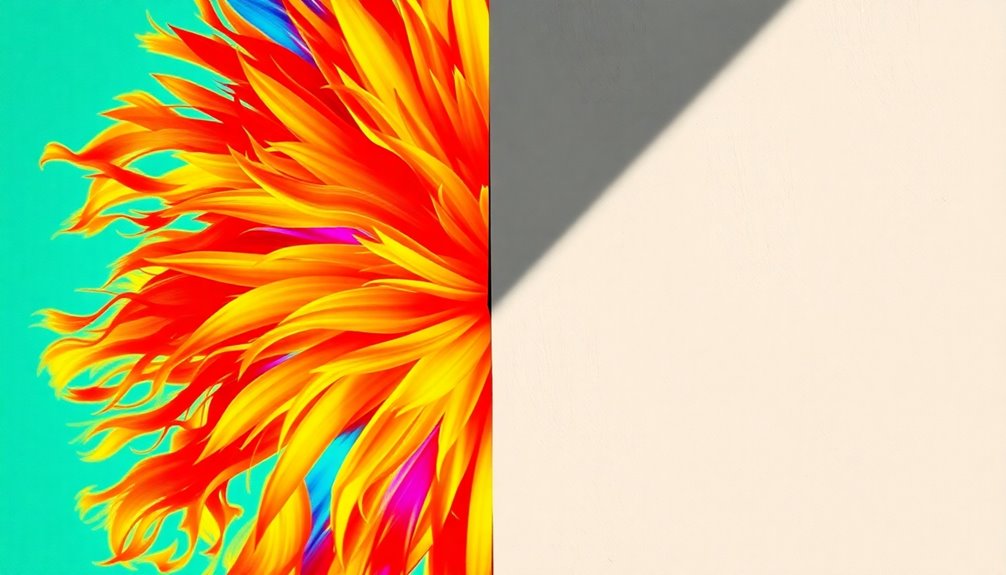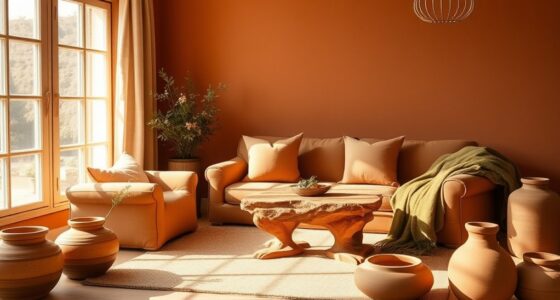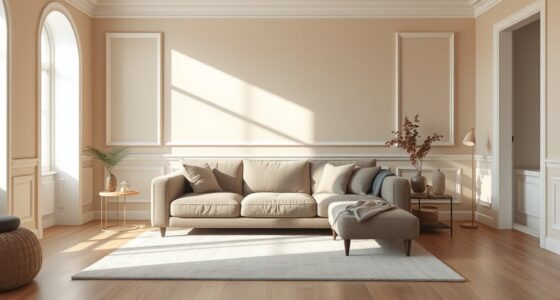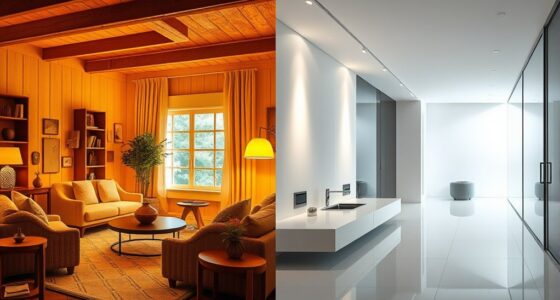Your color choices, bold or neutral, speak volumes about your personality. Bold colors like red and yellow show that you thrive on excitement and activity, enhancing your mood and energy levels. If you prefer neutrals, you're likely someone who values calmness and versatility, creating a peaceful environment around you. This balance reflects your personality traits, with bold colors indicating extroversion and neutrals suggesting introversion. Understanding these connections can empower you in both personal and professional settings. Want to explore how to find your perfect color style? There's more to discover about how colors can influence your life.
Key Takeaways
- Bold colors like red and yellow indicate extroversion, sociability, and a preference for excitement and energy in your personality.
- Neutral colors reflect a calming presence, suggesting introversion and a desire for relaxation and tranquility in your environment.
- Your preferences for cool colors, such as blue and green, may indicate a thoughtful and dependable personality that values peace and serenity.
- Engaging in color analysis can enhance self-awareness, helping you understand how your color choices align with your personality traits.
- Cultural influences can also play a significant role in your color preferences, impacting how you express your personality through color.
Impact of Bold Colors

When you think about bold colors, you mightn't realize how deeply they can influence your emotions and behavior. Colors like red and yellow can energize you, making you feel more alert and excited.
However, these vibrant shades can also provoke strong emotions, which might overwhelm children and the elderly. Bold colors grab your attention and even affect your body, speeding up your heart rate and blood flow.
You may find that red encourages action, while orange boosts your confidence. Additionally, purple can spark your creativity, enhancing your problem-solving skills. Strong, bright colors can lead to overstimulation in vulnerable populations, highlighting the importance of mindful color choices in environments.
Ultimately, bold colors can elevate your mood and motivation, releasing dopamine in your brain, making them powerful tools in shaping your experiences and environment.
Impact of Neutral Colors
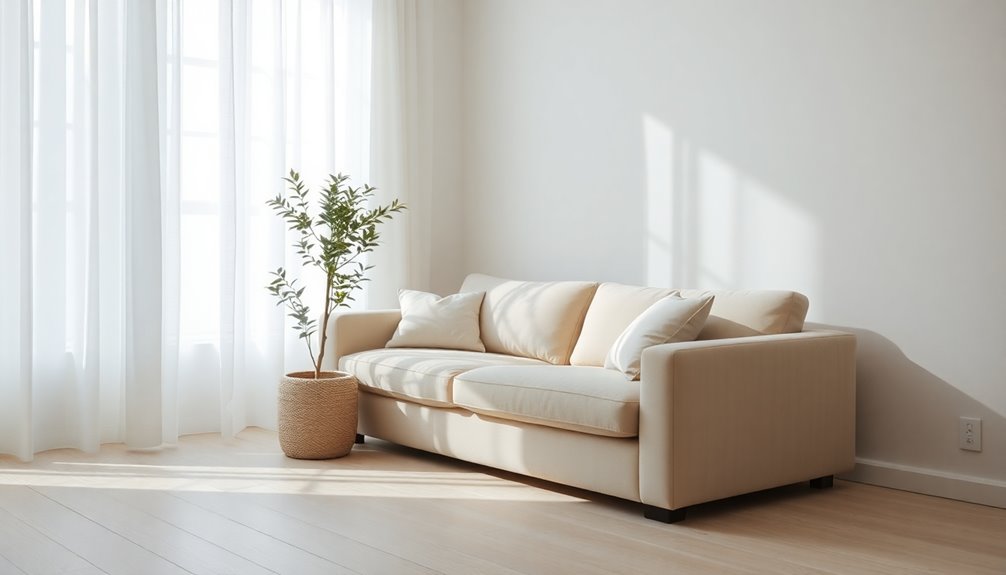
Neutral colors play a crucial role in design, offering versatility and a calming presence that enhances any space. They seamlessly blend with nearly any color or decor style, making them a timeless choice for both short-term and long-term projects.
By providing a serene backdrop, neutral colors promote relaxation and well-being, especially in bedrooms and bathrooms where tranquility is essential. Light neutrals like cream and white can brighten a room, creating an inviting and airy atmosphere that maximizes natural light. Timeless appeal ensures that neutral colors remain relevant in various design trends over time.
These shades are visually pleasing, allowing textures and patterns to shine without interference. Overall, neutral colors create a peaceful environment, encouraging rest and making your space feel larger and more vibrant.
Cool Color Preferences

Colors can significantly influence your mood and environment, and cool colors like blue, green, and purple stand out for their calming effects. If you gravitate towards these hues, you likely value tranquility and serenity.
You may find that your introspective nature allows you to connect deeply with your emotions and appreciate creativity, often engaging in hobbies like art or DIY projects. This connection to nature's calming essence enhances your appreciation for cool colors. Additionally, studies have shown that being surrounded by natural elements can further promote feelings of relaxation and well-being.
Your preference for cool colors suggests you create peaceful, low-key environments where you can unwind and focus on quiet activities like reading or meditation.
With a strong connection to nature and an analytical approach to life, you embody dependability and thoughtfulness. Embracing cool colors not only reflects your personality but also enhances your living space's calming atmosphere.
Stereotypes in Color Choices

While many people may not consciously recognize it, stereotypes surrounding color choices can reveal significant insights into personality traits.
If you lean towards neutral colors like black, gray, or navy blue, you might be an introvert who prefers low-contrast combinations and subtle patterns. These muted tones often create a calming effect that resonates with your personality. Research indicates that significant cultural variations in color preference can also influence individual choices. Additionally, embracing positive thoughts can enhance the calming effect of these colors in your environment.
On the other hand, if you gravitate towards bright colors like red, orange, or yellow, you likely embrace extroversion. High-contrast combinations and bold patterns reflect your vibrant energy and sociability.
Additionally, agreeable individuals often prefer yellows and light blues, while those who are conscientious might choose shades of blue.
Your color preferences can say a lot about who you are.
True Colors Personality Test
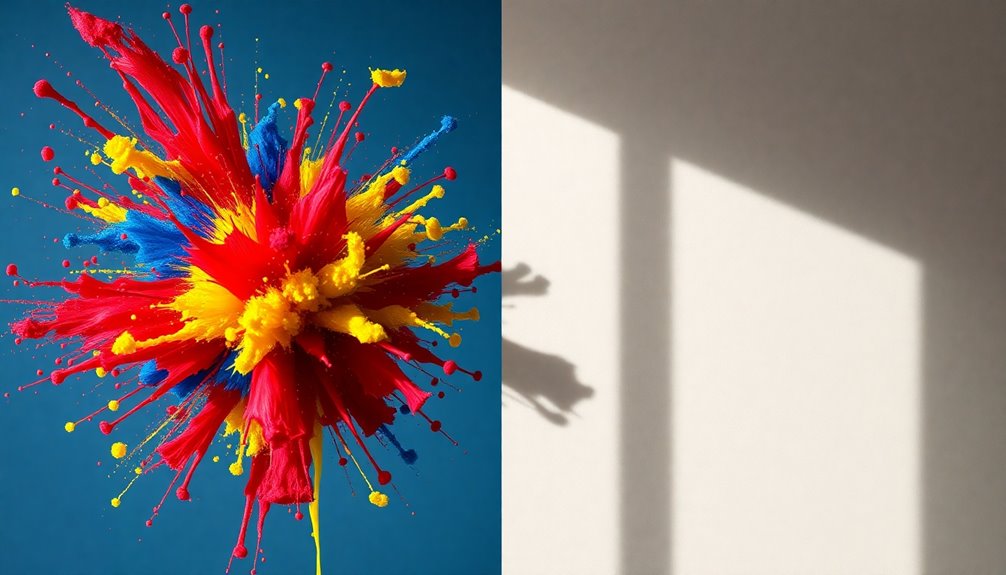
Have you ever wondered how your personality might influence your color preferences? The True Colors Personality Test can help you explore this connection.
Created by Don Lowry in 1978, this test categorizes individuals into four colors: blue, orange, gold, and green, each representing distinct traits. By answering a simple questionnaire about your likes and dislikes, you'll discover your dominant color, which reveals insights into your values and motivations. For example, blue signifies emotional depth while orange embodies excitement. Understanding your primary and secondary colors can enhance your self-awareness and guide your color choices in fashion and design. This tool is widely used in educational settings, helping educators tailor their approach to individual learning styles. Additionally, the test is certified for reliability and validity, making it a trustworthy resource for personal exploration.
Brand Personality and Color

Understanding your personality through tools like the True Colors Personality Test can illuminate how you perceive and select colors. Your brand's visual identity, including its logo and color palette, plays a crucial role in expressing its personality. For instance, Coca-Cola's bold red evokes excitement and is instantly recognizable. Consistent color usage helps your audience identify your brand at a glance and sets the tone for your content. Different colors influence emotions—blue often conveys trust, while yellow radiates optimism. However, remember that cultural differences can alter color interpretations. The strategic use of brand color psychology can enhance your brand's visibility and memorability in a competitive marketplace. Additionally, understanding how literary humor can resonate with your audience may inspire unique color choices that reflect your brand's personality.
Balancing Bold and Neutral
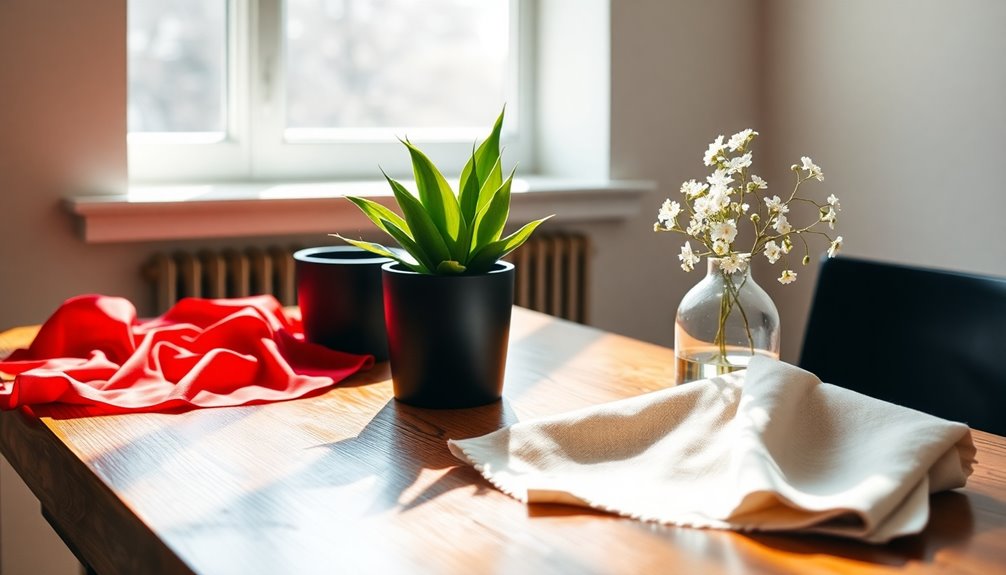
Balancing bold and neutral colors creates a harmonious environment that reflects your personality and style. Start by establishing a neutral base with muted furniture and neutral walls, providing a calming backdrop for bold accents. Incorporate a mix of warm and cool tones in your neutrals, using light and dark shades to add depth. Be mindful of undertones to avoid overwhelming the space. Additionally, consider that neutral pieces create an airy and spacious atmosphere, enhancing the overall feel of your design.
Introduce bold accents, like vibrant cushions or artwork, set against this neutral background to energize the room. Strive for a cohesive palette that enhances your overall aesthetic, reflecting your unique style. Remember to use colors thoughtfully, avoiding common mistakes like overusing similar undertones, ensuring a balanced and inviting atmosphere.
Finding Your Color Style

How can you discover the colors that truly resonate with your personality? Start by taking color psychology tests that rank your preferences, revealing your main traits and stress sources. Consider the True Colors Test, which identifies your primary temperament through orange, gold, blue, and green. Next, assess whether you lean towards warm or cool undertones. Understanding your contrast level—deep, light, clear, or pure—will guide you in choosing flattering hues. Follow a step-by-step color analysis to determine your best palette, enhancing your wardrobe choices. Additionally, these tests can help you identify your four main personality types, providing insights into your motivations and desires. Engaging in practices such as self-reflection can further deepen your understanding of how colors influence your emotional well-being. Finally, wear colors that empower you, boosting your confidence and making you feel unstoppable. Embrace this personalized approach to find the shades that truly reflect who you are!
Frequently Asked Questions
How Can I Combine Bold and Neutral Colors in My Wardrobe?
To combine bold and neutral colors in your wardrobe, start by pairing bold pieces with neutral tones for balance.
For example, wear a bright top with black jeans or layer a vibrant dress with a beige cardigan.
Use neutral colors to tone down bold hues and enhance their appeal.
Experiment with accessories to add pops of color without overwhelming your outfit, and don't hesitate to mix patterns and textures for added interest!
What Colors Should I Avoid if I Have a Calming Personality?
If you're aiming for tranquility, it's wise to steer clear of colors that might stir your spirit too much.
Bright reds and oranges can provoke stress, while intense yellows might disrupt your calm.
Dark hues like navy and forest green can evoke sadness, and vibrant purples may overwhelm your senses.
Instead, embrace softer, muted tones that nurture serenity, allowing your inner peace to flourish without distraction.
It's about creating a soothing atmosphere for yourself.
Can My Color Preferences Change Over Time?
Yes, your color preferences can definitely change over time.
As you grow and experience different stages of life, your tastes may shift. Social and cultural influences, along with your personal memories and emotional states, can also play a role.
For instance, you might find that certain colors resonate differently depending on your mood or even the trends around you.
Embrace these changes; they reflect your evolving personality and experiences!
How Do Cultural Influences Affect Color Personality Associations?
Cultural influences on color personality associations are like vibrant threads weaving through a tapestry of human experience.
Your perceptions of colors can shift dramatically based on cultural context. For example, while red may ignite passion for you, it might symbolize mourning for someone else.
Understanding these nuances helps you appreciate how different backgrounds shape emotional connections to colors, revealing the rich diversity in how people interpret and respond to their surroundings.
What Role Do Seasonal Trends Play in Color Preferences?
Seasonal trends significantly influence your color preferences by reflecting the hues associated with each season.
You might find yourself drawn to spring's pastels or the warm tones of fall, as these colors evoke specific emotions and moods.
By incorporating trendy seasonal colors into your wardrobe, you not only stay fashionable but also align your style with your personality.
Mixing these shades can create a unique palette that resonates with how you feel throughout the year.
Conclusion
Ultimately, your color style is like a personal signature—bold strokes for the daring and soft shades for the serene. Whether you gravitate toward vibrant hues or prefer the calm of neutrals, it's all about expressing who you are. Embrace your unique palette and don't shy away from experimenting. After all, life's too short for a dull canvas. Find the balance that resonates with your personality and let your true colors shine!
